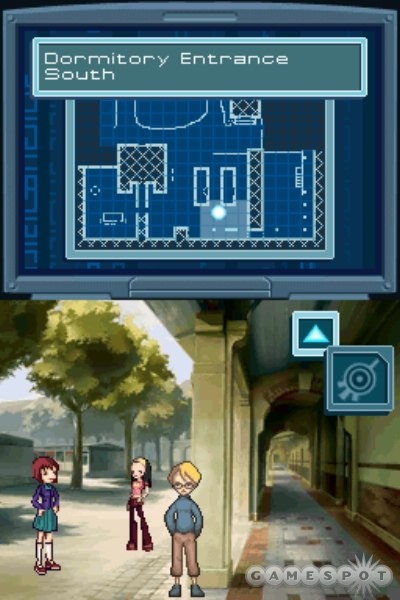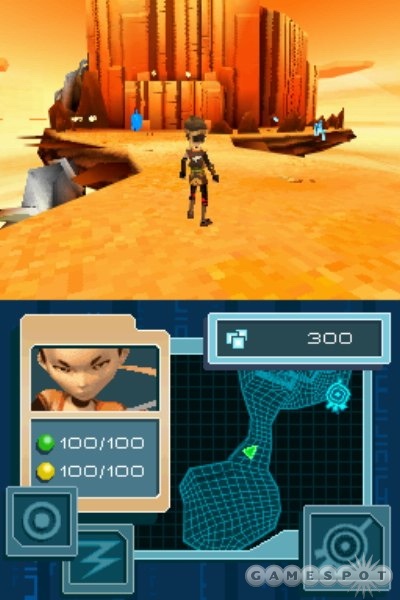Code Lyoko is a French-made animated series that has gained some popularity in North America thanks to a stint on the Cartoon Network. The show hasn't exploded like Digimon or Ben 10, but it has amassed enough of a following for Game Factory to produce a video game based on the series for the Nintendo DS. It employs a mixture of 2D point-and-click adventure levels and 3D action levels to guide players through a hands-on retelling of the show's first three seasons. Younger fans of the show will likely enjoy watching the story gradually unfold as they constantly use the characters' superpowers to fight monsters in Lyoko's virtual world. However, the game's sluggish pace, repetitive combat, and straightforward puzzles guarantee that older or experienced players will lose interest long before the story reaches its conclusion.

If you're not familiar with the show, all you really need to know is that it follows the exploits of four boarding-school students who make frequent trips into a virtual world called Lyoko to battle monsters unleashed by an evil digital entity known as X.A.N.A. In the real world, the kids go to class, hang out, and get into the typical sort of mischief that kids do. In the virtual world, they use their enhanced strength and special abilities to blast monsters or navigate the high-tech obstacle courses that lead to X.A.N.A's towers. Just like the show, some events in the game take place in the real world and some take place in the virtual world. Each of the 15 chapters is split into two portions. One portion is a PC-style 2D point-and-click adventure, where you take control of one of the characters to visit different locations, talk to people, gather items, and generally watch the story unfold. The other portion is a 3D action level where you swap among characters and use their abilities to fight monsters, hop between platforms, or climb up hillsides in search of the tower that'll put and end to whatever problem is currently pestering the real world.
Aesthetically, the game is a treat. The hand-drawn artwork in the real-world levels provides a nice contrast to the 3D structures and monsters in the virtual-world levels. From a technical perspective, the 3D worlds are large, while the engine has no trouble pushing all of the textured polygons for the characters, enemies, and terrain without a hint of slowdown. There aren't many sound effects to accompany the action--just a few laser blasts--but that's not a huge deal because there's a smorgasbord of music that varies from soothing to upbeat to match the situation. The controls are also friendly; they jibe with the dualism that the game and the show are trying to convey. In the real-world levels, you use the D pad to move the active character around and tap the touch screen to interact with people or pick up objects. In the virtual world, you'll find yourself primarily tapping the buttons to attack enemies and activate your shields, only using the touch screen to occasionally change characters or activate special abilities.
After you've gone back and forth between the real world and Lyoko a couple times, the allure of the different art styles wears off. You'll also start to realize that the game is constantly holding your hand and asking you to repeatedly do the same things. The pace in the real-world portions is slow with zero mystery because the map always shows you exactly where to go and what areas to search. Going from point A to point B and various points in between just to see a couple lines of dialogue gets old fast, especially when every subsequent story segment takes longer to play out than the one before. But in the 3D action levels, it's nice that each character has a unique set of attacks. For example, Ulrich and Odd feel like two very different characters because one uses swords, while the other uses a laser crossbow. There are also some tricky sections involving moving platforms.

Unfortunately, those tricky platforms are the only lively aspect of the 3D levels. Enemies spawn at predictable intervals and generally just sit there while you carve them up. Occasionally, you'll find yourself blocked by an obstacle that necessitates the use of a specific character's ability. That's a nice gimmick, but going back to a checkpoint for no reason other than to change characters just so you can run fast, lift a tree stump, or climb up a hill seems like a big waste of time. The developer tried to mix things up with touch-screen puzzles and a few vehicle-based levels. However, they're way too easy and also come across as a waste of time.
It takes about 10 hours to get through roughly 40 levels and 15 chapters while the game holds your hand the whole way through. Younger players probably won't mind the repetition and hand-holding, but if you're old enough to be surfing the Internet to read this review, you're probably too old to enjoy what the Nintendo DS's rendition of Code Lyoko has to offer.



